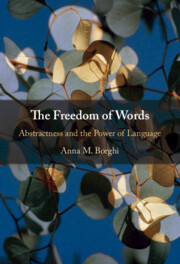Book contents
- The Freedom of Words
- The Freedom of Words
- Copyright page
- Dedication
- Contents
- Figures
- Acknowledgments
- Introduction
- Part I Language and Its Power
- Part II Abstractness and Language
- Chapter 5 Different Varieties of Abstract Concepts
- Chapter 6 Abstractness and Language as a Physical Tool
- Chapter 7 Abstractness and Language as an Inner Tool
- Chapter 8 Abstractness and Language as a Social Tool
- Chapter 9 Conclusion
- Index
- References
Chapter 8 - Abstractness and Language as a Social Tool
from Part II - Abstractness and Language
Published online by Cambridge University Press: 20 July 2023
- The Freedom of Words
- The Freedom of Words
- Copyright page
- Dedication
- Contents
- Figures
- Acknowledgments
- Introduction
- Part I Language and Its Power
- Part II Abstractness and Language
- Chapter 5 Different Varieties of Abstract Concepts
- Chapter 6 Abstractness and Language as a Physical Tool
- Chapter 7 Abstractness and Language as an Inner Tool
- Chapter 8 Abstractness and Language as a Social Tool
- Chapter 9 Conclusion
- Index
- References
Summary
Chapter 8 shows that the idea that words are social tools particularly suits abstract concepts. I first review studies on conceptual acquisition in infants and children, highlighting the crucial role social and linguistic experiences play, particularly for abstract concepts. I then review studies showing that contexts referring to social situations are more effective for processing abstract than concrete concepts. The importance of social and linguistic experiences makes it necessary to adopt new methods for studying abstract concepts. These methods, which consider language a form of participatory sense-making, focus on online dialogic interactions. The final section outlines the proposal that abstract concepts have an essential social function, enhancing social cohesion. One of the possible reasons why they are so common might be linked to our need to share and co-construct our world with others. This need is particularly evident with words, like abstract ones, the meaning of which is less anchored to perceptual stimuli and more debatable and flexible.
Keywords
- Type
- Chapter
- Information
- The Freedom of WordsAbstractness and the Power of Language, pp. 255 - 287Publisher: Cambridge University PressPrint publication year: 2023



